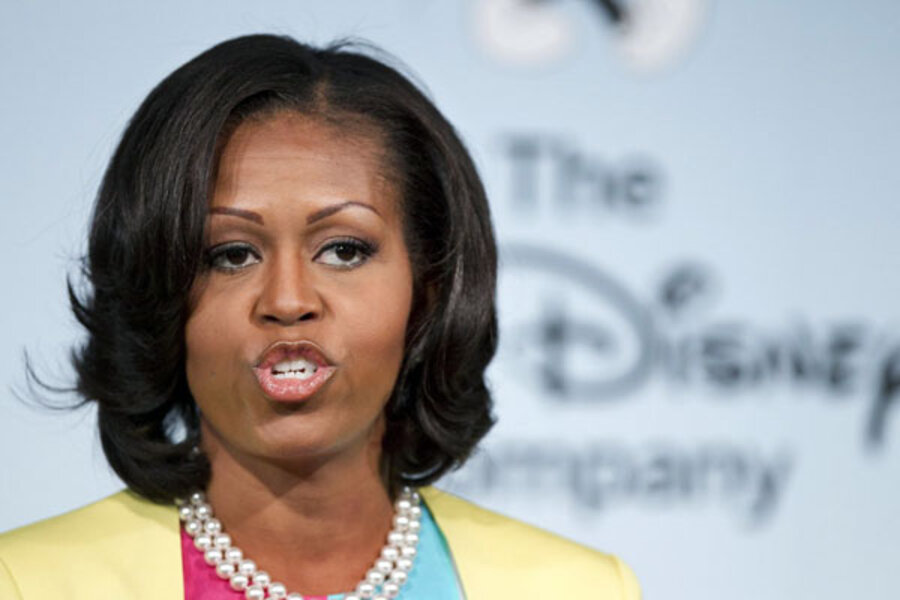Disney bans junk-food ads during children's programming
Loading...
| NEW YORK
Disney says its programming will no longer be sponsored by junk food.
The Walt Disney Co. said Tuesday that it will become the first major media company to ban such ads for its TV channels, radio stations and websites intended for children. That means kids watching Saturday morning children's shows on Disney's ABC network will no longer see ads for fast foods and sugary cereals that don't meet company's nutrition standards.
The guidelines won't go into effect until 2015 because of existing advertising agreements.
At an event announcing the push, First Lady Michelle Obama called the announcement a "game changer."
"Just a few years ago if you had told me or any other mom or dad in America that our kids wouldn't see a single ad for junk food while they watched their favorite cartoons on a major TV network, we wouldn't have believed you," Obama said.
Disney's announcement could pressure other media companies to follow suit at a time when concerns over obesity rates are growing.
Last week, Mayor Michael Bloomberg proposed a ban on sugary drinks bigger than 16 ounces in New York City restaurants, movie theaters and stadiums. City officials say they believe it will ultimately push governments around the U.S. to adopt similar rules.
Disney says its guidelines are aligned with federal standards to promote the consumption of fruits and vegetables and reduce the intake of sodium, sugar and saturated fat.
The kids' meals offered by traditional fast-food chains may not meet the new advertising guidelines, even if the meals come with healthy side orders, says Leslie Goodman, Disney's senior vice president of corporate citizenship. That's because Disney will be assessing the restaurant's broader offerings in deciding whether to approve ads.
"It's not just about reformulating a meal for a single advertising opportunity," Goodman said. The company will have to show it offers a broader menu of healthier options, she said.
For example, a complete meal under Disney's guidelines could have no more than 600 calories. A side dish could have no more than 200 calories.
Without naming specific companies, Goodman said there are ads currently running on Disney channels that would not meet the new standards.
Disney CEO Bob Iger said there might be a short-term reduction in advertising revenue, but that he hopes companies will eventually create products that meet the standards so they don't have to avoid advertising withDisney.
Aviva Must, chairwoman of the Department of Public Health and Community Medicine at Tufts School of Medicine, said Disney could succeed where government thus far has made little progress.
"There seems to be limited taste for government regulation," said Must, who has studied childhood obesity for decades. "So I think a large company like Disney taking a stand and putting in a policy with teeth is a good step."
Margo Wootan, nutrition policy director at the Center for Science in the Public Interest, said that while some snack foods of limited nutritional value may still be advertised, the worst of the junk foods will be eliminated under the new policy.
She hopes Disney's decision triggers similar changes with other companies.
"Disney's announcement really puts a lot of pressure on Nickelodeon and Cartoon Network and other media to do the same," she said.
A spokesman for Nickelodeon declined to comment.
The latest push by Disney is an extension of the internal nutrition guidelines the company launched in 2006, with the goal of making 85 percent of the food and drinks served at its parks and resorts healthy. The remaining 15 percent was reserved for special treats, such as cake for birthday celebrations. The company also stopped using toys in kids meals to advertise its movies, Iger said.
Visitors to parks and resorts were also given the option of trading out soda and fries for low-fat milk and fruit.Disney says 60 percent of the meals served are now with those healthier options.
The company on Tuesday also introduced its "Mickey Check" seal of approval for nutritious foods sold in stores, online and at its parks and resorts.
"The emotional connection kids have to our characters and stories gives us a unique opportunity to continue to inspire and encourage them to lead healthier lives," Iger said.
It isn't the first time a major company is pledging to improve marketing to children.
In 2006, the Better Business Bureau and major food companies launched the Children's Food and Beverage Advertising Initiative, which is intended to encourage healthier food choices.
Sixteen companies including Burger King Corp., Campbell Soup Co., The Coca-Cola Co. and Mars Inc. have signed up for the initiative.
The initiative calls for participating companies to ensure by 2014 that all advertising aimed at children are devoted only to better-for-you foods, as established by government standards.







